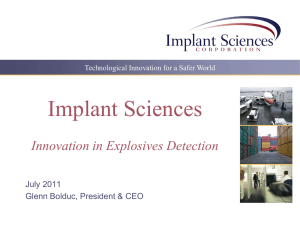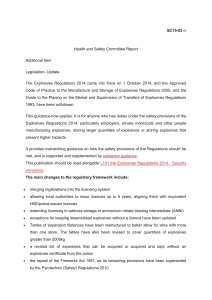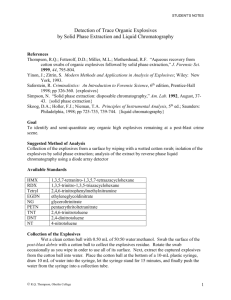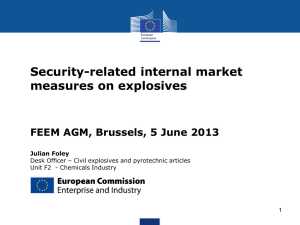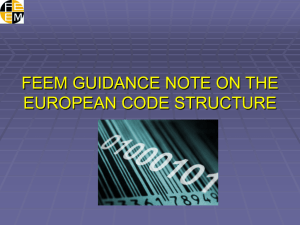(DRAFT) MINUTES OF THE MEETING of the Transport WORKING
advertisement
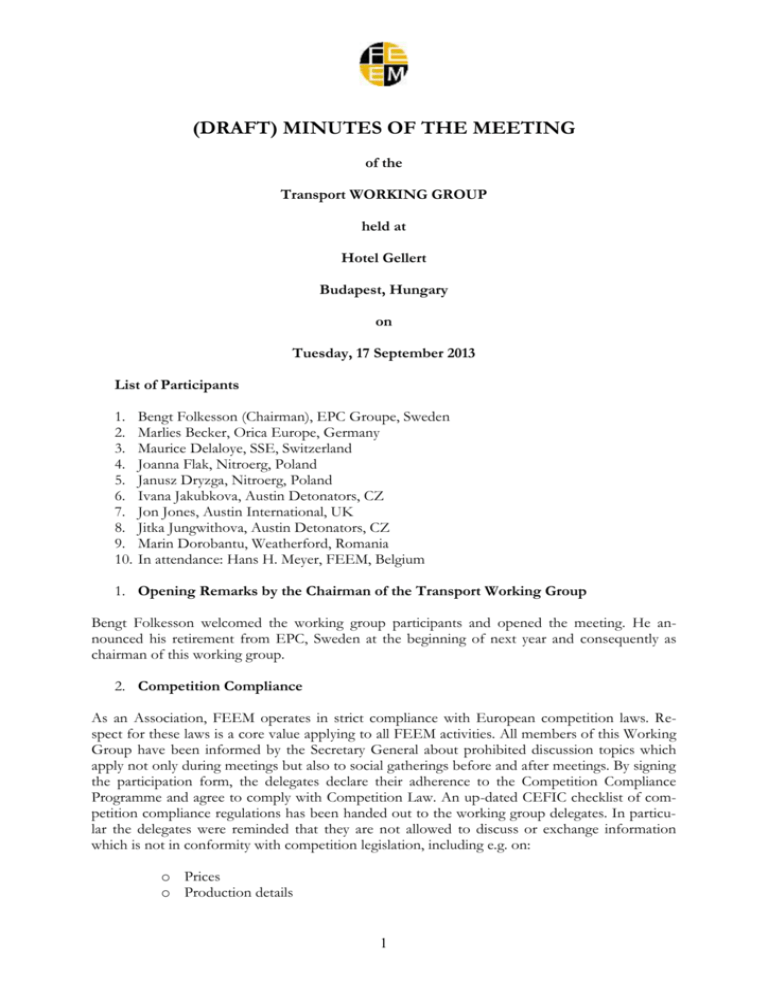
(DRAFT) MINUTES OF THE MEETING of the Transport WORKING GROUP held at Hotel Gellert Budapest, Hungary on Tuesday, 17 September 2013 List of Participants 1. 2. 3. 4. 5. 6. 7. 8. 9. 10. Bengt Folkesson (Chairman), EPC Groupe, Sweden Marlies Becker, Orica Europe, Germany Maurice Delaloye, SSE, Switzerland Joanna Flak, Nitroerg, Poland Janusz Dryzga, Nitroerg, Poland Ivana Jakubkova, Austin Detonators, CZ Jon Jones, Austin International, UK Jitka Jungwithova, Austin Detonators, CZ Marin Dorobantu, Weatherford, Romania In attendance: Hans H. Meyer, FEEM, Belgium 1. Opening Remarks by the Chairman of the Transport Working Group Bengt Folkesson welcomed the working group participants and opened the meeting. He announced his retirement from EPC, Sweden at the beginning of next year and consequently as chairman of this working group. 2. Competition Compliance As an Association, FEEM operates in strict compliance with European competition laws. Respect for these laws is a core value applying to all FEEM activities. All members of this Working Group have been informed by the Secretary General about prohibited discussion topics which apply not only during meetings but also to social gatherings before and after meetings. By signing the participation form, the delegates declare their adherence to the Competition Compliance Programme and agree to comply with Competition Law. An up-dated CEFIC checklist of competition compliance regulations has been handed out to the working group delegates. In particular the delegates were reminded that they are not allowed to discuss or exchange information which is not in conformity with competition legislation, including e.g. on: o Prices o Production details 1 o Transportation rates o Market procedures 3. Agenda for 17 September 2013 and Approval 1. Opening remarks the chairman 2. Compliance with the European and National Competition Laws and Regulations 3. Approval of the Agenda 4. Minutes of the last meeting on 12 March 2013 in Brussels and approval 5. Secretary General’s Report with, in particular: i. Upgrade of FEEM Guidance Note on the European Explosives Code Structure (final version) ii. Trace & Track Directive after implementation of 1st step & UEPG’s (European Federations of Aggregate, Cement & Mining Ind.) Action Plan regarding European process of cascading down to national end-user organisations. iii. FEEM’s interaction with EU commission concerning the European ban to export some types of civil explosives and all the initiation systems to certain countries. 6. Review and up-date of GN no. 9: Security, Transport & Distribution 7. Any other business i. Security-related internal market measures on explosives on EU Commission Level ii. Transport related incidents & accidents iii. Transport of 1.5 ANFO in Road Tankers iv. European Statistics 2012 8. Subjects for discussion at the next meeting 9. Date, place and time of next meeting The Agenda was approved. 4. Minutes of the Transport Group Meeting of the held on 12 March 2013 in Brussels and Approval. The Minutes were approved. 5. Secretary General’s Report The Secretary General up-dated the delegates and gave his presentation on the following topics: a. Upgrade of FEEM Guidance Note on the European Code Structure After several meetings we finally agreed on the modifications and approved the final version at our March 2013 meeting in Brussels. In April FEEM distributed the document to the Members & end-user organisations (e.g. UEPG, EASSP, Euromines, EURACOAL, EFEE, Eurocement, EU Commission, Notified Bodies and Competent Authorities). The text with its appendices was edited on our home-page. 2 The following are the main modifications. Field Digits Format Application Identifier Country & Production Site No. 5 AlphaNumeric (90) Unique Item No. OR Logistical Unit No. 30 AlphaNumeric (250) Determination of items and logistical units Production Date Product Code 2 Numeric (20) Product Variant Fixed Optional 6 Numeric (11) Fixed Optional 30 AlphaNumeric (240) Variable up to 30 characters Optional Batch Number Trade Quantity 20 (10) Variable length Optional 8 AlphaNumeric Numeric (37) Variable Length Optional Quantity 8 Numeric (30) Product Date (YYMMDD) Additional Product Identification Assigned by Manufacturer Batch or lot number Count of items contained in a logistic unit Variable Count Variable Length Optional Fixed Optional Specified units of measure e.g. length / volume etc. Gross weight Kgs Fixed Optional Fixed Optional Company Internal Information Variable length Optional Net Explosive Quantity Unit of Measure 6 Numeric (310n) 6 Numeric (311n-316n) Gross weight 6 Numeric (330n) Internal Use 30 AlphaNumeric (91) – (99) AI Description Length Notes Mutually agreed between trading partners Variable but used as a fixed number to 5 digits Secondary Serial No. Variable up to 30 characters Mandatory to comply with Directive e.g. FR002 – France, 2nd site Mandatory to comply with Directive Collective number of individual items Product net weight in kgs 3 The following three fields may be used according to the GS1 definitions: Field Digits Format Application Identifier Global Trade Item Number Serial Number 14 Numeric (01) GTIN Variable length Optional 20 Alphanumeric (21) Original Serial number for GTIN item Variable length Optional 18 Numeric (00) Serialized Shipping Container Code Fixed Optional SSCC AI Description Length Notes Concerning the visibility of AI we stipulated: The Application Identifiers are not normally visible within a code, but if they were, they are recognised by being two, three or four digit numbers within brackets. AI may optionally be printed on the labels in order to make it easier for a human to read the label and to facilitate key entry in the event that the symbol cannot be scanned. IDENTIFICATION OF DISTRIBUTORS AND RE-PACKAGERS The country and production site number stored in AI (90) will be assigned by NATIONAL AUTHORITIES only for MANUFACTURERS and IMPORTERS of explosives. But DISTRIBUTORS which repackage explosives shall also mark the packaging units with associated labels according to this Guidance Note. Logistical units like boxes or pallets should be marked to facilitate the data transfer in the supply chain. So undertakings without an official production site number shall also use AI (90) as a mandatory field to provide the uniqueness of the identification code. To avoid confusion with official production site numbers of producers and importers AI (90) for those undertakings is FIXED TO 5 LETTERS, TWO FOR THE COUNTRY followed by THREE FOR THE REPACKING COMPANY. Since there is no legal obligation to mark packages for repacking companies those 3 letters company codes do not need to be agreed by national authorities. HOWEVER IT IS IMPORTANT TO MAKE SURE THESE CODES ARE UNIQUE IN EACH COUNTRY. CONTENTS OF AI (20) 00: Item 01: Inner packaging 02: Intermediate packaging 03: Outer packaging 04: Pallet 05: Container 09: Ad hoc FURTHER LEVELS OF PACKING BEYOND 09 SHALL NOT BE USED. 4 If suitable additionally to the mandatory fields AI90 and AI 250 the following information may be added to the code in strict compliance with GS1 standard: AI (00): SSCC AI (01): GTIN AI (21): SERIAL NUMBER UNITS OF MEASURE Explosives articles may be marketed (and consequentially tracked) in a range of units of measure, i.e. weight, length, volume, etc. The global standards specify AIs (311n) to (316n) as UNITS OF MEASURE that can be applied and incorporated within the barcode (if applicable). The AI (311n) and up use always a PREDEFINED unit of measure, (e.g. meters for (311n), cubic meters for (316n), kg for (330n)). Additional information about unit of measure like the UN/ECE codes can be used inside GS1 code in the customer specific fields AI(91) to (99). Inside the XML file they may be used at special field “UNIT OF MEASURE”. For list of international UN/ECE codes and definitions refer to Annex III. GTIN (AI 01) A GLOBAL TRADE ITEM NUMBER (GTIN) is used to identify any item upon which there is a need to retrieve pre-defined information and that may be priced or ordered or invoiced at any point in any supply chain. A separate unique GTIN is required whenever any of the pre-defined characteristics of an item are different in any way that is relevant to the trading process (e.g. unit of measure). SERIAL NUMBER (AI 21) – UNIQUE NUMBER Serial number for GTIN identified item. The AI 21 is the standard serial number for items that are identified with a GTIN. The serial number will be the unique code assigned for the unique identification of each single unit. Although usually called a number, it may include letters, though ending with digits. This Unique Item Number field would also be used for identification of LOGISTICAL UNIT NUMBERS, i.e. a bag or a case, etc. providing identification & traceability at that level also. For pallets it is an option, but usually the SSCC is used in international trading. SSCC (AI 00) (SERIALIZED SHIPPING CONTAINER CODE) The SSCC is the (GS1) Identification Key for an item of any composition established for transport and/or storage which needs to be managed through the supply chain. The SSCC is assigned for the life time of the transport. It is using Application Identifier (00). b. UEPG’s (European Federations of Aggregate, Cement & Mining Ind.) Action Plan regarding European process of cascading down to national end-user organisations. 1. The Secretary General informed the delegates about the JOINT TASK FORCE between UEPG, EU Commission and FEEM with the aim to develop an ACTION PLAN towards a simple guidance for END-USERS on the main duties for 5 1. 2. 3. 4. 5. 6. 7. 8. the implementation of the Directive by the whole supply chain. Besides FEEM, UEPG and the Commission the following organisations are involved through their European and National associations: European Cement Association –CEMBUREAU European Association of Mining Industries, Metal Ores & Industrial Minerals – EUROMINES European Association for Coal and Lignite – EURACOAL European Association of Industrial Minerals –IMA – Europe, European Federation of Explosives Engineers German Blasting Association EFEE European Trade Association – industriAll TTE-Europe GmbH – Dresden Informatik On 21st August 2013 a GUIDANCE DOCUMENT and COVER LETTER has been distributed to the NATIONAL MINERAL‘S ASSOCIATIONS with the request for further distribution to all their members to support proper and timely implementation of Commission Directive 2008/43/EC on a system for the identification and traceability of explosives for civil uses. Primarily the following recommendations were given as “Obligations for Users/Distributors – Directive 2008/43/EC consolidated, from 5 April 2015”: Users of explosives have to comply with the following obligations as from 5 April 2015: 1. Putting in place a system for collecting data in relation to explosives including their unique identification throughout the supply chain and life cycle. 2. Keeping a record of all identifications of explosives, together with all pertinent information including the type of explosive, the company or person to the custody of whom it was given; (...) for a period of 10 years after the delivery or whenever known after the end of the life cycle of the explosive even if undertakings have ceased trading. 3. Recording the location of each explosive while the explosive is in their possession or custody until it is either transferred to another undertaking or used. 4. At regular intervals testing their data collection system in order to ensure its effectiveness and the quality of the data recorded. 5. Protecting the data collected against accidental or malicious damage or destruction. 6. Providing the competent authorities, upon their request, with the information concerning the origin and location of each explosive during its life cycle and throughout the supply chain. 7. Providing the responsible Member State authorities with the name and contact details of a person able to provide the information described in the previous point outside normal business hours. c. FEEM’S INTERACTION WITH EU COMMISSION CONCERNING THE EUROPEAN BAN TO EXPORT SOME TYPES OF CIVIL EXPLOSIVES AND ALL THE INITIATION SYSTEMS TO CERTAIN COUNTRIES There is a European Ban to export some types of civil explosives and all the initiation systems to certain countries with INTERNAL REPRESSION. This is regulated under “The Wassenaar Arrangement (full name: The Wassenaar Arrangement on Export Controls for Conventional Arms and Dual-Use Goods and Technologies)” which is a multilateral export control regime (MECR) 6 with 41 participating states including many former COMECON (Warsaw Pact) countries. The European Union has specific prohibitions to export certain type of products to certain “sensible countries”, because they could be used for “internal repression”. Some of the countries are • • • • • • • • Belarus, Republic of Guinea, Iran, Ivory Cost, Libya, Myanmar, Syria, Zimbabwe The following products are of concern: There are several International and Multinational Companies working in these countries in the fields of: Exploration projects for fuel and gas, Cement, Iron, Fertilizers, Aluminium, Precious Metals (Gold, Silver, and Platinum) and other Minerals and Raw Materials which require explosives imports from Europe. FEEM is trying to modify the list allowing all initiating devices to be exported to reliable enduser in these countries without restrictions. 6. Review and up-date of GN no. 9: Security, Transport & Distribution The existing Guidance Note from before 2004 is should be up-dated because of a number of changes and new regulations on national and EU level. The Track & Trace Directive is only one of the relevant documents which should be included. Other regulations relative to ADR and the 48 measures from the EU Action Plan of enhancing the security of explosives are also not considered. The delegates have been asked to check on Security Management Systems already in 7 place in their companies which could be incorporated into such a paper. The Secretary General will compile this information and review the GN based on this input. 7. Any other Business The Secretary General gave an overview concerning 1. Security-related internal market measures on explosives on EU Commission Level & SCEPYLT Status 1. Regulating commercial explosives on internal market: 1. Implementation of Council Directive 93/15/EEC on the harmonisation of the provisions relating to the placing on the market and supervision of explosives for civil uses 2. Commission Decision 2010/347 amending Decision 2004/388/EC on an Intra-Community Transfer of explosives document 3. Commission Directive 2008/43/EC as amended by Directive 2012/4/EU setting up, pursuant to Council Directive 93/15/EEC, a system for the identification and traceability of explosives for civil uses 2. Explosives Action Plan 3. Adaptation of Explosives Directive to New Legislative Framework for the marketing of goods on the internal market 4. Implementing Regulation 98/2013 on the marketing and use of explosives precursors 5. Outlook 2. Transport related incidents & accidents a. Since the last meeting in Brussels there were no reports about transport incidents 3. Transport of 1.5 ANFO in Tanks a. FEEM is of the opinion that for security & safety reasons this issue will not actively be supported. There is no further information concerning the reference tests by BAM. 4. European Explosives Statistics a. The Secretary General gave on overview of the 2012 numbers. 5. Bengt Folkesson: Reversible Transfer Documents When returning a consignment / product to the original supplier (e.g. in case of a claim) the returnee has to file a new application for transfer papers. Is there the possibility for a simplified procedure (“reverse transit document”)? This issue will be taken up at the next meeting of Explosives Experts in Brussels on 18 October 2013. Bengt will prepare a paper for this meeting. 6. THIRD PARTY SALES The following question came up: In a classic third party sales scenario, an external supplier stores goods in his warehouse and fulfils an order in our name. So the cus- 8 tomer orders goods with us and we ask for direct delivery from the third party to the customer. The third party supplier scans and delivers the goods, but sends his invoice to us and we send our invoice to the customer. Our understanding is that the third party supplier is responsible for scanning the products and as well providing the sASN to the end-customer. Is that correct? FEEM’s position: The physical supplies of explosives to a customer from a consignment stock is always in the responsibility of the distributor/custodian (third party), because he – as the explosives licence holder of the explosives’ magazine – is responsible for the legally regulated EXPLOSIVES INVENTORY REGISTER. Therefore, under T&T Directive the distributor/custodian (3rd party) is responsible for the necessary steps of tracking the explosives at every stage throughout its life cycle and also for keeping the records of every uniquely identified article to be maintained and to be available for inspection for a period of 10 years. The Commission has confirmed this view: Chapter 3 of the Directive relating to data collection and record-keeping provides that all undertakings in the explosives sector collect and maintain data relating to each explosive in their possession or custody throughout the supply chain and life cycle until it is transferred to another undertaking or used. The requirements would thus extend to third party distributors/suppliers. 7. The POD - Proof of Delivery: (i.e. a signature from the receiving party that the products have been handed over) is, to our understanding, not a regulatory requirement in the tracking and tracing of explosives right now. Nevertheless the question was raised, if there was a requirement coming from Track and Trace that either truck drivers or customers do this POD and if the signature would have to be electronically or if e.g. a manual hand-over signature (as done today) is sufficient. If I remember right, your summary of the EU meeting October 25th 2012 provided the information, that truck drivers are excluded - for the time being - from any tracking and tracing requirement in regards to directive 2008/43 and 2012/04. But a confirmation would be greatly appreciated. Answer Commission: As regards POD, the Directive is silent on the methods used to record information about the location, transfer, use, etc. of the explosive. This is a matter for the undertakings concerned. 8. Subjects for discussion at the next meeting a. Review and up-date of GN no. 9: Security, Transport & Distribution b. Benchmarking: Safety & Security in Transport; Thierry Rousse has offered himself for a presentation for the autumn 2014 meeting. 9. Date and place of the next meeting Tuesday, 25 March 2014 at Hotel AMARILIS 9 Prague 1, Štěpánská 18 tel: +420 222 748 111-2 fax: +420 222 748 113 amarilis@jerome.cz www.hotelamarilisjerome.com The meeting was closed by the chairman Bengt Folkesson at 1:30 p.m. The Secretary General thanked Bengt for his excellent contributions as a Chairman to this group and wished him all the very best for the future. 10
